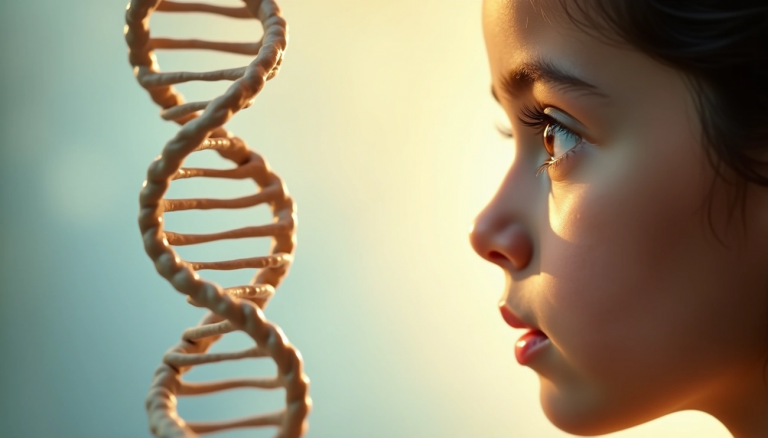Think about the feeling of unwrapping a gift — that spark of anticipation, the little rush of joy that follows. Your brain feels something remarkably similar when curiosity strikes. The moment you become genuinely interested in something, it releases dopamine, the same chemical that lights up your mind when you tear open a present or savor your favorite dessert.
But curiosity isn’t just a delightful quirk of the human mind — it’s a powerful driver of learning. Scientists across neuroscience, psychology, and education have found that when curiosity kicks in, the brain changes how it works. The striatum, a region tied to reward and motivation, becomes more active, flooding the brain with dopamine. That’s why facts discovered through genuine interest tend to stick — while the ones we’re forced to memorize often slip away.
What’s even more fascinating is how early this begins. Studies of seven- to eight-month-old babies show they’re naturally drawn to scenes that are just right in complexity — not too simple, not too overwhelming. Too easy, and they tune out; too confusing, and they look away. From the very beginning, our brains are wired to seek that “sweet spot” between boredom and challenge. It’s a built-in compass for curiosity that guides us throughout life. [1]
In the next part, we’ll look at how this natural curiosity system grows and changes over time — and how understanding it can help you learn faster, remember longer, and fall in love with learning all over again.
However, my curiosity didn’t stop here. I began to wonder — have there been discoveries or innovations that have truly transformed human life? That question sent me down a fascinating path of exploration. The more I looked, the more I found. Here are just a few remarkable examples that curiosity helped bring to life.
1. Penicillin — A Curious Accident That Changed Medicine
In 1928, Alexander Fleming returned from vacation to find that one of his petri dishes had grown mold — and strangely, the bacteria around it had disappeared. Instead of tossing it out, his curiosity made him look closer. That simple question — “Why did this happen?” — led to the discovery of penicillin, the world’s first antibiotic, saving millions of lives ever since.
2. The Light Bulb — Asking “What If?” Until It Worked
Thomas Edison didn’t invent the idea of electric light, but his relentless curiosity pushed him to ask, “What if I try this material instead?” thousands of times. After testing over 6,000 filaments, his curiosity-driven persistence led to a long-lasting bulb — and a revolution in how we live after dark.
3. Potato Chips — A Chef’s Curiosity Turned Complaint into a Snack
In 1853, a customer at a restaurant kept sending his fried potatoes back, complaining they were too thick. Out of curiosity (and a bit of spite), Chef George Crum sliced the potatoes’ paper-thin, fried them crisp, and seasoned them heavily. The customer loved them — and potato chips were born. A tasty case of curiosity and experimentation at work.
4. Coffee — “Why Are Those Goats So Energetic?”
Legend says an Ethiopian goat herder named Kaldi noticed his goats dancing energetically after eating bright red berries. Curious, he tried them himself — and felt an unusual burst of energy. That simple curiosity led to the discovery of coffee, now a global morning ritual.
5. Cornflakes — Curiosity in the Kitchen
In 1894, John Harvey Kellogg accidentally left cooked wheat out overnight. The next day, it went stale — but when he ran it through rollers, it flaked. Instead of tossing it, he baked the flakes and served them. His curiosity about the texture and taste launched a breakfast revolution.
Above are just five examples; the list could go long. However, the idea or a solution is to find ways to change the way our kids learn. Let them go explore, and we can instill such habits by demonstrating similar behaviors. A simple change we can make is: When kids ask questions, we should encourage them to go find the answers, rather than give them the answers.
How Curiosity Changes Throughout Life
“I have no special talents. I am only passionately curious.” — Albert Einstein, Theoretical Physicist, Nobel Laureate
The patterns of human curiosity follow predictable stages, each with distinct characteristics and intensities. Infants begin exploring within hours of birth—reaching, grasping, and examining everything within their environment. This early drive establishes the foundation for all future learning.
Adolescence shifts the focus entirely. Social curiosity overtakes factual curiosity as teenagers become intensely interested in peer relationships and social hierarchies. This period also sees the emergence of specialized interests—music, sports, technology—that often develop into lifelong passions.
Many people assume curiosity fades with age. The evidence suggests otherwise. While processing speed may slow, older adults maintain robust curiosity about meaningful topics. Studies show seniors display heightened interest in history, cultural topics, and existential questions. Those who stay curious throughout their lives demonstrate better cognitive health, with research indicating that sustained mental exploration builds cognitive reserves that may protect against dementia.
The remarkable aspect of curiosity lies in its adaptability. Rather than diminishing, it evolves to match our changing interests and capacities at each stage of life. What begins as physical exploration becomes intellectual investigation, social understanding, and eventually wisdom-seeking—a lifelong journey of mental growth.
How Curiosity Boosts Learning and Memory
“We learn more by looking for the answer to a question and not finding it than we do from learning the answer itself.” — Lloyd Alexander, Author, Newbery Medal Winner
Curiosity doesn’t just make learning feel more exciting — it actually changes how well we remember.
A group of researchers at the University of California discovered something remarkable: when people are genuinely curious about a topic, their brains hold onto the information far better. It’s as if curiosity flips a mental switch, sharpening focus and guiding the brain to store what truly matters.
But here’s where it gets even more fascinating. Curiosity doesn’t just help you remember that one thing you’re interested in — it opens a wider door. When your mind is curious about one subject, it becomes more receptive to everything else happening around it. Imagine reading about black holes and then, somehow, also remembering the random fact you heard about the ocean that same day. Curiosity creates a kind of “mental readiness,” preparing your brain to absorb and connect ideas more freely.
Inside your brain, this magic happens through a few key processes. When curiosity sparks, the hippocampus — the brain’s main memory hub — begins working overtime, processing details more deeply. At the same time, dopamine surges strengthen the connections between neurons, helping those memories stick. And as you start asking questions, your brain naturally begins to organize information into meaningful patterns, creating a framework that makes learning feel both effortless and rewarding.
This is exactly how scientists think. Instead of passively accepting information, they question it — why does this happen? What if it worked differently? That constant curiosity keeps their brains alert, ready to encode new knowledge and link it to what they already know.
The result is powerful: stronger, longer-lasting memories and a deeper understanding that grows each time curiosity sparks again.
Final Thoughts
Curiosity isn’t just a pleasant feeling — it’s a built-in learning accelerator, wired deep into our brains. Every time curiosity sparks, it sets off a cascade of changes inside the mind, turning learning from a task into an adventure.
Over the course of this exploration, one truth stands out: curiosity doesn’t simply motivate us — it reshapes how our brains work. It sharpens focus, strengthens memory, and transforms information into understanding that lasts.
Our brains have evolved to treat curiosity as a kind of reward system — just like food or shelter. That’s why discovering something new feels genuinely satisfying. When students learn out of genuine interest, their brains reward them twice: once for seeking answers, and again for finding them. This double dose of pleasure keeps curiosity alive, creating a cycle where learning fuels itself.
Even more fascinating is curiosity’s ripple effect. When we’re curious about one topic, our minds open-up to everything around it. A curious brain doesn’t just learn more — it learns better. By nurturing curiosity, we build the mental flexibility to connect ideas across subjects, making learning a whole brain experience rather than a single-track pursuit.
And curiosity, it turns out, doesn’t fade with age — it evolves. Studies show that people who keep asking questions and exploring new ideas maintain sharper thinking and better cognitive health. Curiosity may just be one of the most powerful tools we have for lifelong growth.
So, if there’s one takeaway, it’s this: questions are the gateway to learning. Each time you wonder why or how, your brain wakes up — ready to connect, explore, and remember. Cultivating that mindset doesn’t just make you more knowledgeable; it keeps your mind alive, adaptable, and endlessly curious.
“Stay curious. That’s where every great discovery begins.”
Curiosity About Curiosity: Your Questions, Answered
By now, you’ve seen how curiosity shapes the way we think, learn, and grow. But like any good story, it doesn’t end there — it invites more questions. What happens in the brain when curiosity sparks? Does it fade as we grow older, or simply evolve? And can staying curious actually keep the mind healthy?
Below, we explore some of the most common questions about curiosity and learning — and the surprising science behind what keeps our minds endlessly hungry for answers.
Q1. How does curiosity enhance our ability to learn?
Curiosity does more than spark interest — it literally changes the way your brain learns. When you’re genuinely curious, your brain’s reward system releases dopamine, the chemical that fuels focus and motivation. This creates a state of heightened attention, where your mind becomes fully engaged. In this state, the hippocampus — the brain’s main memory center — works more efficiently, storing information more deeply and helping you remember it longer. In short, curiosity turns learning into something your brain wants to do.
Q2. Does curiosity change as we age?
It does — but not in the way most people think. Curiosity grows and shifts throughout life. It begins in infancy, when babies explore the world through touch and sound. It peaks in childhood’s famous “why?” phase, transforms into social and self-focused curiosity during adolescence, and often matures into a search for meaning and mastery in adulthood. Rather than fading with age, curiosity simply changes its shape — following our evolving interests and life experiences.
Q3. Can curiosity benefit our mental health?
Absolutely! Curiosity keeps the mind active, flexible, and resilient. Engaging new ideas stimulates cognitive pathways and strengthens the brain, much like exercise strengthens muscles. Research shows that people who stay curious tend to experience greater life satisfaction and may even protect their brains from cognitive decline. In essence, curiosity doesn’t just feed the mind — it helps keep it healthy.
Q4. Why is scientific curiosity particularly effective for learning?
Scientific curiosity begins with a simple habit: asking questions. Each question triggers the brain’s curiosity circuits, priming it to absorb, connect, and make sense of information. Instead of memorizing facts, you start weaving knowledge into a bigger picture — a process that strengthens memory and deepens understanding. That’s why scientists, who constantly question and explore, are some of the most effective lifelong learners.
Q5. How does curiosity affect incidental learning?
Here’s one of curiosity’s hidden superpowers: when you’re deeply curious about one thing, your brain becomes more open to everything else around it. Researchers have found that people remember unrelated information better when they’re already engaged by a curious topic. It’s as if curiosity flips the brain into a “learning mode,” making it easier to absorb knowledge from all directions — even things you weren’t trying to learn in the first place.
References:



